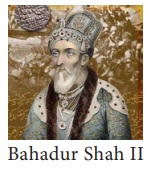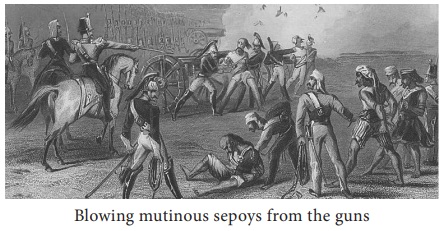Anti-Colonial Movements and the Birth of Nationalism | India - The Great Rebellion of 1857 | 10th Social Science : History : Chapter 7 : Anti-Colonial Movements and the Birth of Nationalism
Chapter: 10th Social Science : History : Chapter 7 : Anti-Colonial Movements and the Birth of Nationalism
The Great Rebellion of 1857
The Great Rebellion of 1857
In 1857,
British rule witnessed the biggest challenge to its existence. Initially, it
began as a mutiny of Bengal presidency sepoys but later expanded to the other
parts of India involving a large number of civilians, especially peasants. The
events of 1857ŌĆō58 are significant for the following reasons:
1. This was the first major revolt of armed forces
accompanied by civilian rebellion.
2. The revolt witnessed unprecedented violence,
perpetrated by both sides.
3. The
revolt ended the role of the East India Company and the governance of the
Indian subcontinent was taken over by the British Crown.
(a) Causes
i. Annexation Policy of British India
In the
1840s and 1850s, more territories were annexed through two major policies:
The Doctrine of Paramountcy. British claimed themselves as paramount,
exercising supreme authority. New territories were annexed on the grounds that
the native rulers were inept.
The Doctrine of Lapse. If a
native ruler did not have male heir to
the throne, the territory was to ŌĆślapseŌĆÖ into British India upon the death of
the ruler. Satara, Sambalpur, parts of the Punjab, Jhansi and Nagpur were
annexed by the British through the Doctrine of Lapse.
ii. Insensitivity to Indian Cultural Sentiments
In 1806
the sepoys at Vellore mutinied against the new dress code, which prohibited
Indians from wearing religious marks on their foreheads and having whiskers on
their chin, while proposing to replace their turbans with a round hat. It was
feared that the dress code was part of their effort to convert soldiers to
Christianity.
Similarly,
in 1824, the sepoys at Barrackpur near Calcutta refused to go to Burma by sea,
since crossing the sea meant the loss of their caste.
The
sepoys were also upset with discrimination in salary and promotion. Indian
sepoys were paid much less than their European counterparts. They felt
humiliated and racially abused by their seniors.
(b) The Revolt
The
precursor to the revolt was the circulation of rumors about the cartridges of
the new Enfield rifle. There was strong suspicion that the new cartridges had
been greased with cow and pig fat. The cartridge had to be bitten off before
loading (pork is forbidden to the Muslims and the cow is sacred to a large
section of Hindus).
On 29
March a sepoy named Mangal Pandey assaulted his European officer. His fellow
soldiers refused to arrest him when ordered to do so. Mangal Pandey along with
others were court-martialled and hanged. This only fuelled the anger and in the
following days there were increasing incidents of disobedience. Burning and
arson were reported from the army cantonments in Ambala, Lucknow, and Meerut.
Bahadur Shah Proclaimed as Emperor of Hindustan
On 11 may
1857 a band of sepoys from Meerut marched to the Red Fort in Delhi.

The
sepoys were followed by an equally exuberant crowd who gathered to ask the
Mughal Emperor Bahadur Shah II to become their leader. After much hesitation he
accepted the offer and was proclaimed as the Shahenshah-e-Hindustan (the
Emperor of Hindustan). Soon the rebels captured the north-western province and
Awadh. As the news of the fall of Delhi reached the Ganges valley, cantonment
after cantonment mutinied till, by the beginning of June, British rule in North
India, except in Punjab and Bengal, had disappeared.
Civil Rebellion
The
mutiny was equally supported by an aggrieved rural society of north India.
Sepoys working in the British army were in fact peasants in uniform. They were
equally affected by the restructuring of the revenue administration. The sepoy
revolt and the subsequent civil rebellion in various parts of India had a
deep-rooted connection with rural mass. The first civil rebellion broke out in
parts of the North-Western provinces and Oudh. These were the two regions from
which the sepoys were predominately
recruited. A large number of
Zamindars and Taluqdars were also attracted to the rebellions as they had lost
their various privileges under the British government. The talukdarŌĆōpeasant
collective was a common effort to recover what they had lost. Similarly,
artisans and handicrafts persons were equally affected by the dethroning of
rulers of many Indian states, who were a major source of patronage. The dumping
of British manufactures had ruined the Indian handicrafts and thrown thousands
of weavers out of employment. Collective anger against the British took the
form of a peopleŌĆÖs revolt.

Prominent Fighters against the British
The
mutiny provided a platform to aggrieved kings, nawabs, queens, and zamindars to
express the anti-British anger. Nana Sahib, the adopted son of the last Peshwa
Baji Rao II, provided leadership in he Kanpur region. He had been denied
pension by the Company. Similarly, Begum Hazrat Mahal in Lucknow and Khan Bahadur
in Bareilly took the command of their respective territories, which were once
ruled either by them or by their ancestors.
Another
such significant leader was Rani Lakshmi Bai, who assumed the leadership in
Jhansi. In her case Dalhousie, the Governor General of Bengal had refused her
request to adopt a son as her successor after her husband died and the kingdom
was annexed under the Doctrine of Lapse. Rani Lakshmi Bai battled the mighty
British Army until she was defeated.
Bahadur
Shah Jafar, Kunwar Singh, Khan Bahadur, Rani Lakshmi Bai and many others were
rebels against their will, compelled by the bravery of the sepoys who had
defied the British authority.
(c) Suppression of Rebellion
By the
beginning of June 1857, the Delhi, Meerut, Rohilkhand, Agra, Allahabad and
Banaras divisions of the army had been restored to British control and placed
under martial law.
(d) Causes of Failure
There is
hardly any evidence to prove that the rebellion of 1857 was organised and
planned. It was spontaneous. However, soon after the siege of Delhi, there was
an attempt to seek the support of the neighboring states. Besides a few Indian
states, there was a general lack of enthusiasm among the Indian princes to
participate in the rebellion. The Indian princes and zamindars either remained
loyal or were fearful of British power. Those involved in the rebellion were
left with either little or no sources of arms and ammunition. The emerging
English-educated middle class too did not support the rebellion.

One of
the important reasons for the failure of the rebellion was the absence of a
central authority. There was no common agenda that united the individuals and
the aspirations of the Indian princes and the various other feudal elements
fighting against the British.
In the
end, the rebellion was brutally suppressed by the British army. The rebel
leaders were defeated due to the lack of weapons, organisation, discipline, and
betrayal by their aides. Delhi was captured by the British troops in late 1857.
Bahadur Shah was captured and transported to Burma.

(e) India Becomes a Crown Colony
The
British Parliament adopted the Indian Government Act, in November 1858, and
India was pronounced as one of the many crown colonies to be directly governed
by the Parliament. The responsibility was given to a member of the cabinet,
designated as the Secretary of State for India.
Changes in the Administration
British
rule and its policies underwent a major overhaul after 1857. British followed a
cautious approach to the issue of social reform. Queen Victoria proclaimed to
the Indian people that the British would not interfere in traditional
institutions and religious matters. It was promised that Indians would be
absorbed in government services. Two significant changes were made to the
structure of the Indian army. The number of Indians was significantly reduced.
Indians were restrained from holding important ranks and position. The British
took control of the artillery and shifted their recruiting effort to regions and
communities that remained loyal during 1857. For instance, the British turned
away from Rajputs, Brahmins and North Indian Muslims and looked towards
non-Hindu groups like the Gorkhas, Sikhs,and Pathans. British also exploited
the caste, religious, linguistic and regional differences in the Indian society
through what came to be known as ŌĆ£Divide and RuleŌĆØ policy.
Related Topics